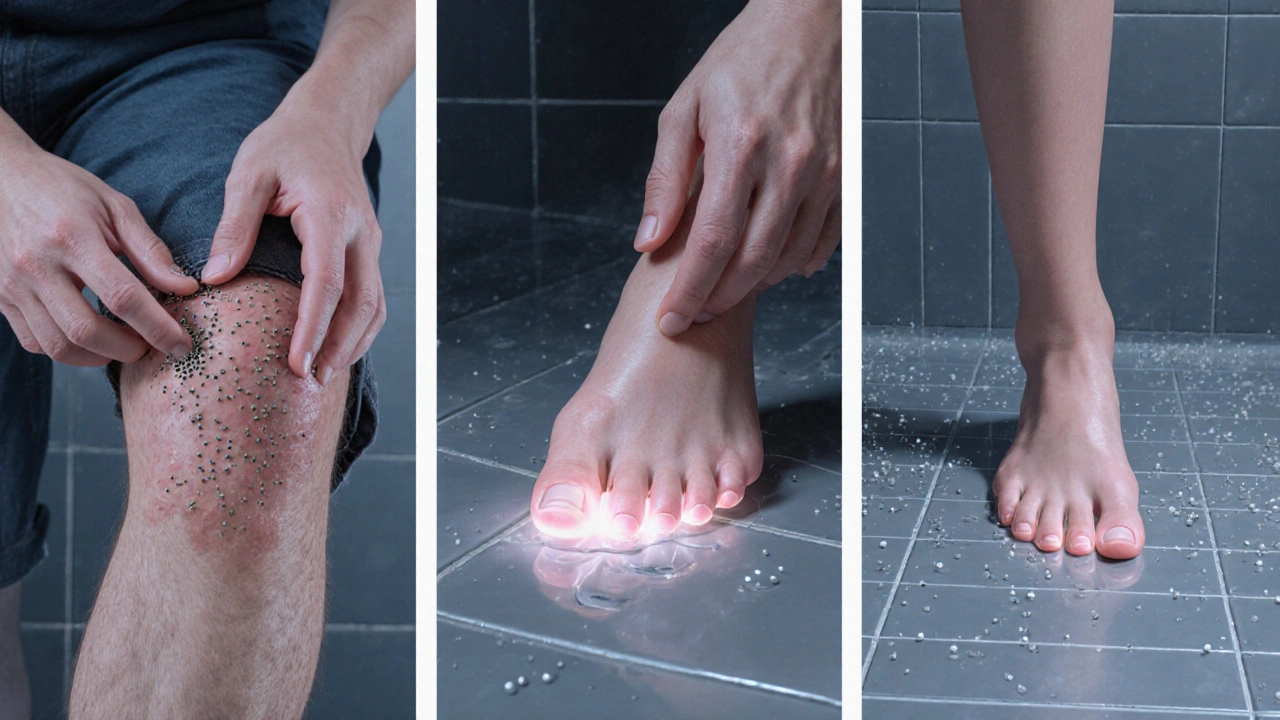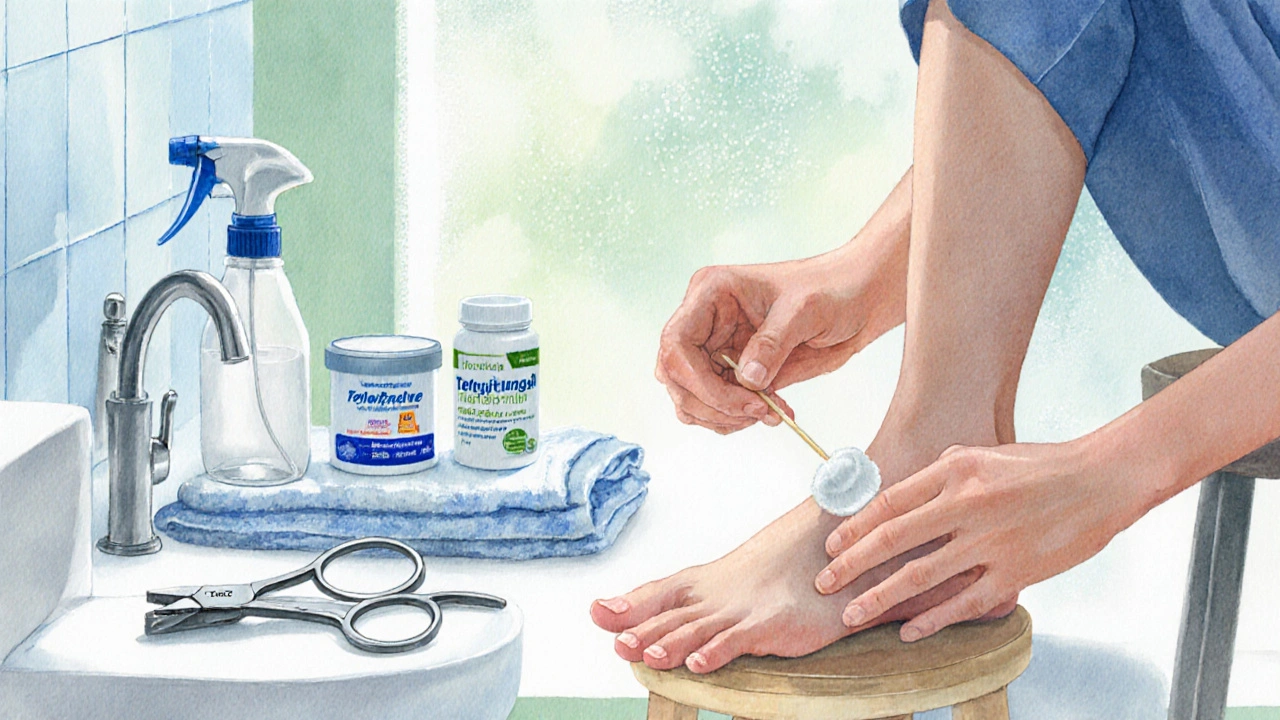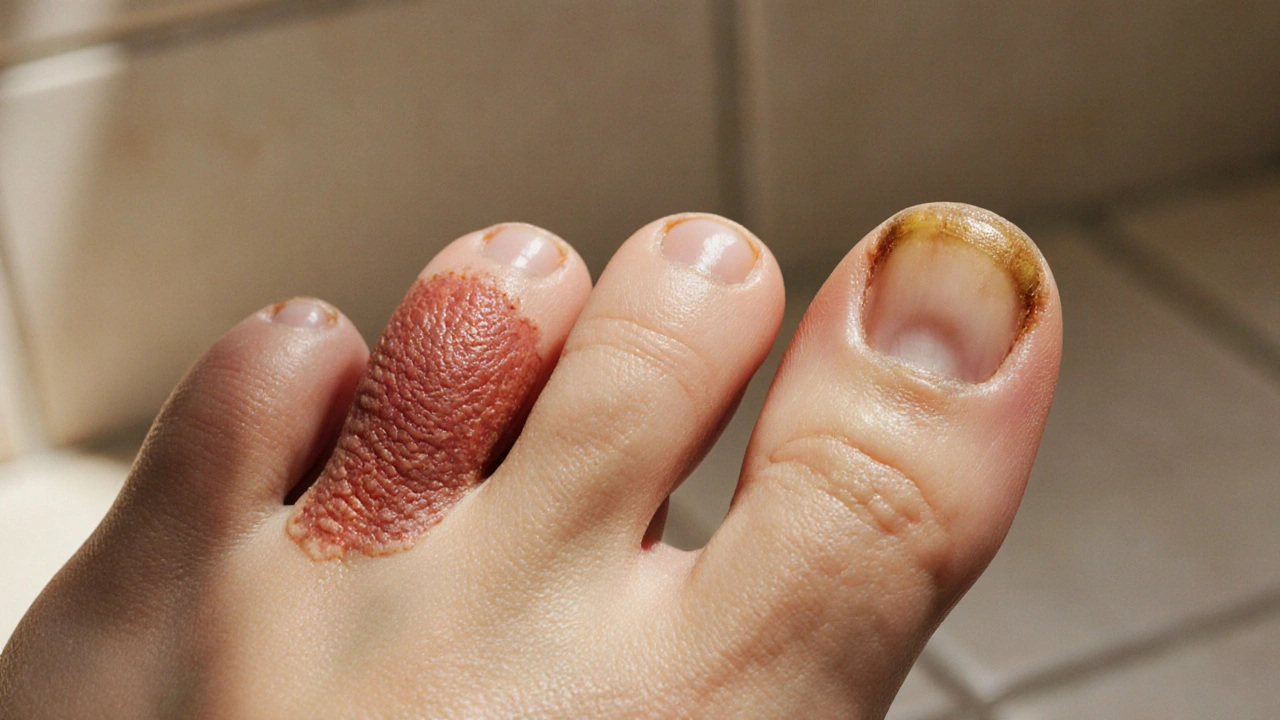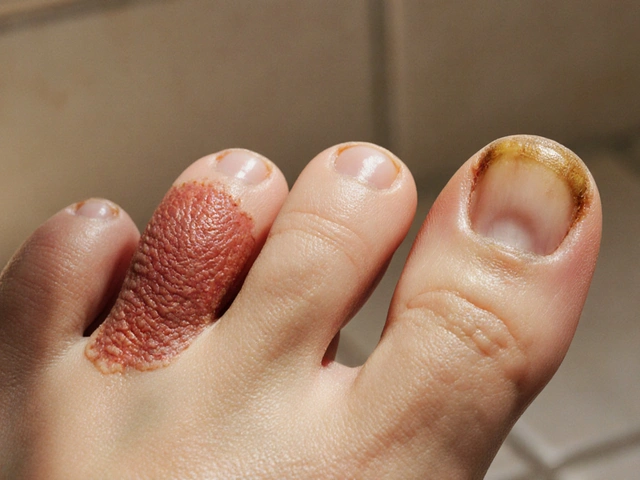Ringworm vs Fungal Nail Infection Quiz
How Well Do You Understand the Connection Between Ringworm and Nail Infections?
When you hear the words Ringworm a common skin infection caused by dermatophyte fungi that feed on keratin and fungal nail infection also known as onychomycosis, a condition where fungi invade the nail plate, you might think they’re completely separate problems. In reality, they share the same family of fungi, and one can easily lead to the other. Below you’ll find everything you need to know about the link, how it spreads, and what you can do about it.ringworm
Key Takeaways
- Both ringworm and fungal nail infections are caused by dermatophyte fungi that love keratin.
- The same fungus can move from skin to nail (and back) through direct contact or contaminated surfaces.
- Symptoms differ: ringworm shows itchy, red patches; nail infection causes thick, discolored nails.
- Over‑the‑counter and prescription antifungal medications can treat both, but nail infections often need longer courses.
- Good hygiene, keeping skin dry, and treating any skin infection promptly can stop the cycle.
What Is Ringworm?
Ringworm, medically called tinea a group of skin infections caused by dermatophytes, appears as a circular, red, scaly patch that may be itchy. It can affect the body (tinea corporis), head (tinea capitis), groin (tinea cruris), or feet (tinea pedis, also known as athlete’s foot). The culprit fungi live on the outer layer of skin, feeding on the protein keratin.
What Is a Fungal Nail Infection?
A fungal nail infection, or onychomycosis infection of the nail plate by dermatophytes, yeasts, or molds, usually starts at the tip of the nail and spreads inward. Affected nails become thick, brittle, yellow‑brown, and may crumble. While anyone can develop it, it’s more common in adults over 40, people who wear tight shoes, and those with compromised immune systems.

The Common Culprit: Dermatophytes
Dermatophytes a group of fungi that specialize in breaking down keratin in skin, hair, and nails include species like Trichophyton rubrum, Trichophyton mentagrophytes, and Epidermophyton floccosum. These organisms thrive in warm, moist environments-think locker rooms, public showers, and sweaty socks. Because they can grow on both skin and nail keratin, they’re the bridge between ringworm and nail infections.
How the Same Fungus Attacks Skin and Nails
The transition from skin to nail (or the other way around) usually follows one of three routes:
- Direct extension: An infected patch on the foot (athlete’s foot) spreads to the toenail margin, where the fungus penetrates the nail bed.
- Self‑inoculation: Scratching a ringworm lesion and then touching the nail area transfers spores.
- Environmental reservoirs: Walking barefoot on a contaminated floor can seed both the skin and the nails simultaneously.
Because the fungi are the same, treating only the skin lesion while ignoring a budding nail infection often leads to recurrence.
Transmission Paths: From Skin to Nail and Vice Versa
- Use of shared towels or socks spreads spores.
- Pet owners can pick up dermatophytes from infected animals, which can land on both skin and nails.
- Cutting or filing nails with contaminated tools introduces the fungus directly into the nail plate.
- Moist environments (swimming pools, gyms) keep spores viable for weeks.

Spotting the Differences: Symptoms and Signs
| Feature | Ringworm (tinea) | Fungal Nail Infection (onychomycosis) |
|---|---|---|
| Typical location | Skin surface (arms, legs, feet, scalp) | Nail plate (toes, fingers) |
| First sign | Red, circular, scaly patch; often itchy | Thickening, discoloration, brittleness |
| Common fungi | Trichophyton rubrum, T. mentagrophytes | Same dermatophytes plus Candida species |
| Diagnosis | Visual exam, skin scraping, KOH test | Nail clipping, culture, sometimes nail‑bed biopsy |
| Treatment length | 2‑4 weeks (topical) or 1‑2 weeks (oral) | 6‑12 weeks (topical) or 12‑24 weeks (oral) |
Treatment Strategies-What Works for Both
The cornerstone of therapy is antifungal medication drugs that inhibit fungal cell wall synthesis or disrupt fungal membranes. Options include:
- Topical agents: clotrimazole, terbinafine cream, or ciclopirox nail lacquer. Ideal for mild skin lesions; nail lacquer works for early nail infection.
- Oral systemic drugs: terbinafine tablets, itraconazole, or fluconazole. These reach the nail bed through the bloodstream and are needed for moderate to severe cases.
- Adjunct measures: keeping feet dry, using antifungal powders in shoes, and removing infected nail material with a professional debridement.
Because oral drugs can affect liver function, a doctor should order baseline blood tests and monitor periodically.
Prevention Tips to Break the Cycle
- Wash hands and feet daily; dry thoroughly, especially between toes.
- Wear breathable footwear; change socks at least once a day.
- Avoid walking barefoot in public showers; use flip‑flops.
- Disinfect nail clippers, pedicure tools, and bathroom surfaces regularly.
- Treat any athlete’s foot promptly; don’t ignore a skin rash.
- If you have a pet with a fungal skin infection, consult a vet and practice good hand hygiene after handling.
By tackling the skin infection first and keeping the environment hostile to fungi, you dramatically lower the chance of nail involvement.
Frequently Asked Questions
Can ringworm turn into a nail infection?
Yes. The same dermatophyte that causes a skin rash can spread to the nail plate, especially when the infection is on the feet. Prompt treatment of the skin lesion reduces this risk.
How long does it take for a nail infection to clear?
Oral antifungals usually require 12‑24 weeks of daily dosing, because nails grow slowly (about 1mm per month). Topical nail lacquer may need 6‑12 months of consistent use.
Is it contagious?
Both conditions are contagious. Spores spread through direct skin contact, shared towels, shoes, or contaminated surfaces. Good hygiene and disinfection are key.
Can over‑the‑counter creams cure nail fungus?
OTC creams work well for mild skin ringworm but are usually insufficient for nail infections. Nail lacquer formulations may help early cases, but most nail infections need prescription oral medication.
What home remedies are effective?
Tea tree oil, Vicks VapoRub, and vinegar soaks have some antifungal properties, but evidence is limited. Use them as adjuncts, not replacements, for medically proven treatments.








King Shayne I
October 12, 2025 AT 20:53Listen, if you dont keep your feet dry you are basically rolli ng out a welcome mat for dermatophytes-stop being lazy about it. A quick change of socks daily and proper ventilation can shut the spore party down. Anyone who thinks a little moisture is harmless just doesn't get the science.
jennifer jackson
October 13, 2025 AT 10:46Great job reading up on the connection. Keep an eye on any red patches and act fast. The sooner you treat skin tinea the less chance it will jump to your nails.
Brenda Martinez
October 14, 2025 AT 00:39Ah, the tangled web of dermatophytes, a saga of keratin‑devouring fiends that thrive where we least expect them.
You think a simple ring around your toe is harmless? Think again.
Those scaly, crimson crescents are not merely cosmetic nuisances; they are harbingers of a deeper invasion.
When the fungus finds a foothold on the skin, it eyes the neighboring nail like a predator stalking its prey.
The nail, composed of dense keratin, offers a banquet of nutrients that the pathogen cannot resist.
Soon, the once‑pristine nail plate begins to thicken, yellow, and crumble under the relentless onslaught.
Patients often ignore the early skin lesion, assuming it will vanish, only to watch the infection metastasize into the nail.
This progression is not a myth; countless case studies document the exact route of direct extension from tinea pedis to onychomycosis.
Moreover, the immune system, already taxed by the skin eruption, struggles to mount an effective defense against the entrenched nail infection.
Oral antifungals become necessary, but they come with hepatic caveats that demand regular blood work.
Topical treatments alone are akin to slapping a mosquito with a feather-ineffective against the deep‑seated fungus.
The real hero in this battle is prevention: dry feet, breathable footwear, and immediate treatment of any skin rash.
Neglecting these basics is tantamount to inviting the fungus to set up a permanent residence.
Even your pets can act as silent reservoirs, shedding spores onto your bathroom tiles.
Thus, the ecosystem of infection spans humans, animals, and the very environments we inhabit.
In short, the connection between ringworm and nail fungus is a relentless relay race, and the only way to win is to intercept the baton at the skin stage.
Marlene Schanz
October 14, 2025 AT 14:33Honestly, the link is pretty simple-once you have athlete’s foot, the fungus just crawls under the nail edge. Keep your socks clean, let your shoes air out, and don’t share towels. Also, using a separate nail clipper for infected toes can save you a lot of trouble later.
Eric Sevigny
October 15, 2025 AT 04:26One thing many people overlook is the role of homemade footbaths. A soak in diluted vinegar or tea tree oil can reduce spore load, but it’s not a cure‑all. Pair that with a proper antifungal cream and you’ll see improvement over a few weeks.
Glenda Rosa
October 15, 2025 AT 18:19Sure, the article says “keep feet dry,” but let’s be real-people love sweaty gym socks. If you’re going to ignore that, at least admit that the fungus is practically indestructible without a prescription cocktail of terbinafine and lifestyle changes.
David Stephen
October 16, 2025 AT 08:13Remember, treating the skin issue first gives you a huge advantage. Even a modest oral dose can clear both the rash and stop the nail from getting infected later on. Stay consistent and you’ll beat the fungus.
John Blas
October 16, 2025 AT 22:06Another fluff piece that pretends the fungus is a simple bug. The reality is far messier, but hey, if you enjoy the drama of thick yellow nails, go ahead.
Matthew Marshall
October 17, 2025 AT 11:59Fungus loves moisture, period.
Lexi Benson
October 18, 2025 AT 01:53Oh great, because we all have time to monitor liver enzymes for months, right? :)
Vera REA
October 18, 2025 AT 15:46Dermatophyte species such as Trichophyton rubrum exhibit keratinolytic activity that enables colonization of both epidermal and onychic tissues, establishing a continuum of infection.
John Moore
October 19, 2025 AT 05:39While aggressive oral therapy is effective, it’s essential to balance efficacy with patient safety; regular monitoring and patient education can harmonize the treatment plan.
Kimberly Dierkhising
October 19, 2025 AT 19:33From a mycological standpoint, the pathogenesis involves adherence of conidia to keratinocytes, enzymatic degradation of disulfide bridges, and subsequent hyphal invasion of the nail matrix-a cascade best addressed with a multimodal regimen.